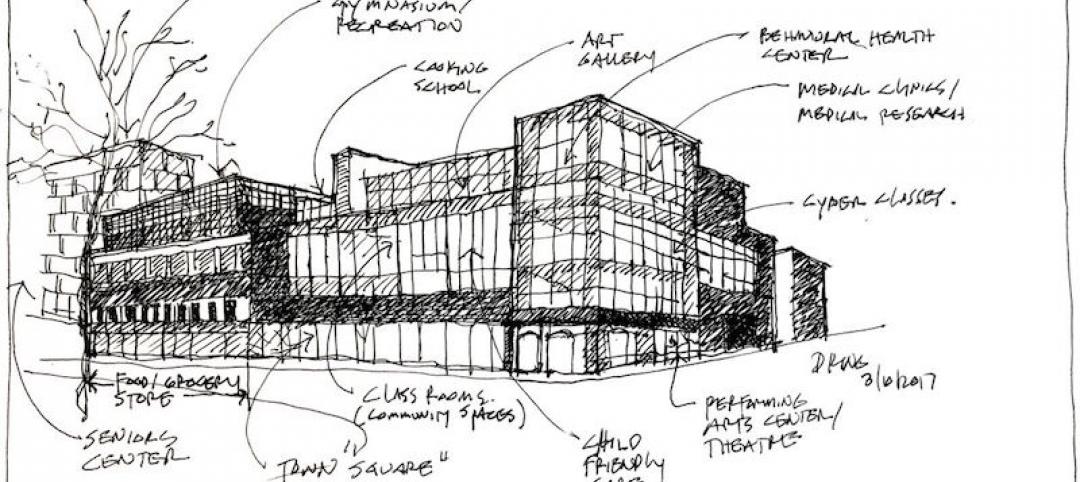 |
| Perkins+Will, with Pei Partnership Architects, designed Ronald Reagan UCLA Medical Center. |
Over the past 30 years or so, the healthcare industry has quietly super-sized its healthcare facilities. Since 1980, ORs have bulked up in size by 53%, acute-care patient rooms by 77%. The slow creep went unlabeled until recently, when consultant H. Scot Latimer applied the super-sizing moniker to hospitals, inpatient rooms, operating rooms, and other treatment and administrative spaces.
It's not just individual rooms that are bloated. Fourteen states are loaded up on more inpatient beds than population data suggests they'll need—for the next 21 years!—even as 14 other states are expected to suffer severe bed shortages (see chart, opposite). Latimer's message to hospital officials: invest wisely, because research shows that the healthcare sector will need a $2 trillion investment by 2030—$1 trillion in new construction, $1 trillion in infrastructure renewal. Super-sized spaces that do not contribute to functionality will be deemed wasteful and financially unsustainable, especially in today's economic environment.
Latimer, AIA, ACHA, a senior partner and managing director in the Denver office of Atlanta-based Kurt Salmon Associates and a past president of the AIA Academy of Architecture for Health, has made it his mission to raise awareness within the architecture community and among healthcare administrators of the need to right-size, not super-size, the nation's hospitals.
 |
Latimer has nearly three decades of data—based on 76 archived projects from client work dating back to 1980—that he's worked into a persuasive argument against super-sizing. At the AIA National Conference in San Francisco last June, he drew a standing-room-only audience.
Latimer sees healthcare designers in a bind. Many of them know their hospital projects are too big, but their fees are linked to project size. “There aren't enough architects to stand up and say, 'Make it smaller and spend money more wisely.'” Architects who do speak up are often challenged by clients who want their facilities designed for what Latimer calls the worst common denominator. “Architects can't abdicate their responsibilities to the leadership of the hospitals,” says Latimer. “They need to ask the hard questions and make the tough calls about what's really justified,” he says. “You can't just design a big room to fit everything and say, 'Boom, there you go, what's next?'”
Latimer says there is a great deal of confusion about how much investment is actually required for the healthcare sector and where beds are most needed. “People are staggered by how much demand there will be for beds in the coming years,” he says. For example, based on population projections through 2030, Arizona, California, Florida, Georgia, North Carolina, and Texas will need 80% of the country's new beds. California alone will need 63,000 new beds by 2030, which is the equivalent of building a new 200-bed hospital every month for the next 25 years, says Latimer.
 |
| The 365,000-sf, 181-bed Seton Medical Center-Williamson in Round Rock, Texas, is one of several recent UHS Building Solutions/HKS-designed healthcare projects that are considered right-sized. The design firm’s patient rooms average 275-300 sf, and at this hospital they come in at 291 sf. |
On the other hand, research indicates that states like New York and Pennsylvania have more than enough inpatient beds to meet demand through 2030. The logical solution, it would seem, would be to fund construction where beds are most needed. That's not the way the system works, however. Instead, many states that don't need more beds are building hospitals anyway.
As you can imagine, not everyone agrees with Latimer. They argue that designing larger spaces gives hospitals more flexibility to use a room for many different functions. But flexibility for what? asks Latimer. “Very seldom are ORs or other rooms changed into something else,” he says.
Others argue that because healthcare is getting more efficient, hospital stays are getting shorter, and more surgery is being done as outpatient procedures, the projection of $2 trillion in new construction and infrastructure is exaggerated. Latimer says, “Okay, say they're right. So, instead of $2 trillion over the next 20 years, we need $1 trillion. That's still a huge number, and there's a big responsibility to use that money wisely.”
To address that problem, Latimer says it is useful to examine three key questions: What has happened since 1980 that's led to hospital super-sizing? How is it possible to determine if increased square footage is justified? And, based on analysis of those two questions, how can hospital administrators and boards spend their capital resource funds most wisely?
A Closer Look at the Numbers
 |
| Since 1980, the healthcare industry has quietly super-sized its healthcare facilities. The average patient room grew by 77%. |
Total hospital size is traditionally based on about 1,500-2,500 gross sf per inpatient bed, but that rule of thumb varies wildly at the macro level, says Latimer, so it's easier to determine justified square footage of specific spaces, such as acute-care patient rooms, ORs, or shell space.
Acute-care patient rooms have swelled in size from around 170 net sf per patient 30 years ago to an average 300-320 net sf per patient today, a 77% increase that can be ascribed in large part to the transition to single-patient rooms. Other factors include ADA requirements for patient-room bathrooms, larger patient beds (they've grown from seven feet in length to almost nine feet over the years, which has super-sized corridors so beds can be turned around), and 24-hour family space—remember the quaint days of “visiting hours”?
“We're not hearing about any new or different functions coming into the patient room indicating it should grow larger, so any additional size would grow it beyond the needs of function,” says Latimer.
 |
| The average operating room increased in size by 53%. |
Operating rooms averaged 460 net sf in 1980; today, they run about 700-750 net sf, an increase of 53%. One reason for today's bigger ORs comes from a merging of technologies: procedures that used to be conducted in multiple smaller rooms now take place in larger single rooms.
Latimer says he has heard of some ORs hitting 1,000 sf. He questions how the additional 250 sf contributes to functionality. “We're not seeing any further merging or hybridization of technologies, and there hasn't been an increase in the number of people touching the patient in the sterile zone, so there's no reason for ORs to continue to grow,” he says.
He notes, too, that ORs are also the most expensive spaces to build—often three to four times more expensive than other parts of a hospital. Latimer concedes the point that, in some instances, a larger OR may be needed to accommodate such equipment as mobile CT or MRI, laminar flow, or robotic single-plane fluoroscopes. But he says that while one or two larger ORs in a surgical floor may be acceptable, an entire floor of super-sized ORs is not.
 |
| Perkins+Will’s 200-sf patient room for Salem Hospital’s North Shore Medical Center in Massachusetts meets family and caregiver needs. |
How much shell space is justified? According to Latimer, none—a very controversial zero—unless yours is one of the few hospitals that can justify the luxury of shell space. Otherwise shell space is simply not justifiable. “I think there's too much demand for space that isn't delivering any services, and the point is to eliminate everything unjustified,” he says.
His reasoning: hospitals should spend every dollar on beds they already have rather than on shell space for future beds. “Even if you know you'll need the beds in 10 years, build them in 10 years and spend the money on what you need now,” he says. At a time when most hospitals have more demands placed on them than they can afford to service, it makes no sense to spend money on shell space, says Latimer.
Latimer sees an obligation on the part of the healthcare AEC community to deliver the right-sizing message to their hospital clients—even if it's not always what the client wants to hear. “There will be a premium for architects who can deliver tight solutions that minimize size and costs,” says Latimer.
Related Stories
Healthcare Facilities | Apr 28, 2017
Can healthcare be retail?
Healthcare systems have much to learn from retail. While they have been laser-focused on delivering exceptional patient care on their primary campuses, they face an onslaught of new challenges as they embrace a retail strategy to expand outpatient services and their ambulatory network.
Healthcare Facilities | Apr 24, 2017
Treating the whole person: Designing modern mental health facilities
Mental health issues no longer carry the stigma that they once did. Awareness campaigns and new research have helped bring our understanding of the brain—and how to design for its heath—into the 21st century.
Sponsored | Glass and Glazing | Apr 14, 2017
Azuria glass from Vitro provides hospital with the desired pop of color
Located in Wilmington, Delaware, Nemours/duPont hospital has undergone a series of expansions since it was founded in the 1940s.
Healthcare Facilities | Apr 14, 2017
Nature as therapy
A famed rehab center is reconfigured to make room for more outdoor gardens, parks, and open space.
Healthcare Facilities | Apr 13, 2017
Investors and developers are still avid for medical office buildings
A new CBRE survey finds that equity set aside for purchases continues to outshoot the availability of in-demand supply.
Healthcare Facilities | Apr 13, 2017
The rise of human performance facilities
A new medical facility in Chicago focuses on sustaining its customers’ human performance.
Healthcare Facilities | Apr 11, 2017
Today’s community centers offer glimpses of the healthy living centers of tomorrow
Creating healthier populations through local community health centers.
Healthcare Facilities | Apr 2, 2017
Comfort and durability were central to the design and expansion of a homeless clinic in Houston
For this adaptive reuse of an old union hall, the Building Team made the best of tight quarters.
Healthcare Facilities | Mar 31, 2017
The cost of activating a new facility
Understanding the costs specifically related to activation is one of the keys to successfully occupying the new space you’ve worked so hard to create.
Sponsored | Healthcare Facilities | Mar 29, 2017
Using Better Light for Better Healthcare
Proper lighting can improve staff productivity, patient healing, and the use of space in healthcare facilities
















